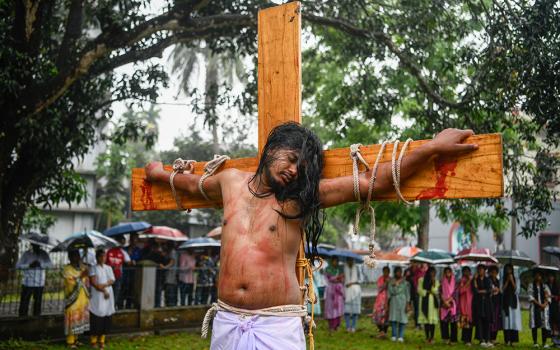BEIRUIT -- When Pope Benedict XVI arrived today at Beirut’s Rafic Hariri airport, the VIP delegation awaiting him consisted of both Christian patriarchs and Muslim clerics, all of whom mingled freely both before and after the welcoming ceremony. The Muslim leaders listened attentively, applauded warmly, and projected a general air of delight.
Later in the day, when the pope went to a Greek Melkite basilica to sign the concluding document from a 2010 Synod of Bishops on the Middle East, the same visuals played out: bishops and muftis, patriarchs and imams, were all on hand.
TV coverage leading up the pope’s arrival had shots of bishops and muftis slapping one another on the back, telling jokes, and sharing quiet conversation.
It’s not just the clerical establishment. Monsignor John Kozar, an American who heads the Catholic Near East Welfare Association and is in Lebanon for the pope’s trip, told NCR he was in a shop recently where the owner identified himself as a Muslim and expressed support for the pope’s arrival.
“The pope is a man of peace,” Kozar quoted the owner as saying, “and we want him with us.”
These images of harmony, of course, come against the backdrop of a Middle East that in other ways seems to be on fire.
Anti-American violence has broken out in various parts of the Islamic world, including another region of Lebanon – Tripoli, about 45 miles to the north, where protestors torched a Kentucky Fried Chicken and a Hardees, and later, one person was killed and two injured in an attempted assault on a government building.
In that sense, Benedict’s visit amounts to a fortuitous way to showcase a different face of the Middle East -- gracious, open, and religious without succumbing to fanaticism. Both it and the violent impulses currently sweeping across the region may be equally real, but the latter usually have a much higher media profile.
Tomorrow morning, the pope is scheduled to meet a delegation of leaders of the four main Muslim communities in Lebanon – Sunni, Shi’ite, Druze and Alawites. Also joining the session will be Bechara Boutros al-Rai, patriarch of the Maronite church, the largest of the Eastern churches here in communion with Rome.
In the streets of Beirut, the crowds who turned out to see the pope today appeared to be a roughly equal mix of Christians and Muslims. One young Lebanese man, who identified himself as a Sunni Muslim, told NCR he came out to see the pope because he knew the visit was important to his Catholic friends, and he wanted to show support.
Malek Mawlawi, head of a youth-oriented Muslim-Christian dialogue committee in Lebanon, said that the overwhelming majority of the country’s Muslims want the visit to go well – in part, he said, to project a positive image of Lebanon on the world stage, and in part to keep the delicate inter-religious peace.
Granted, not every Muslim voice appears thrilled. Earlier, radical sheikh Sheikh Omar Bakri had called on Muslims to prevent the pope from entering the country, saying that a 2006 speech by Benedict in Regensburg, Germany, in which the pope quoted a Byzantine emperor linking Muhammad to violence, amounted to “insulting Islam.”
Lebanese journalist Michel Hajji Georgiou, however, said that aside from a few critics – some radical Islamists, and some avowed secularists – most Lebanese do still value their country’s reputation as a model of co-existence, and see the papal presence as somehow a confirmation of it.
Kozar said that despite security concerns, this is probably the “perfect time” for Benedict to be in the Middle East.
“As opposed to all the ugly things happening elsewhere, his visit shows there’s another way to address what bothers you,” Kozar said.
“This is the church at its best,” he said.



